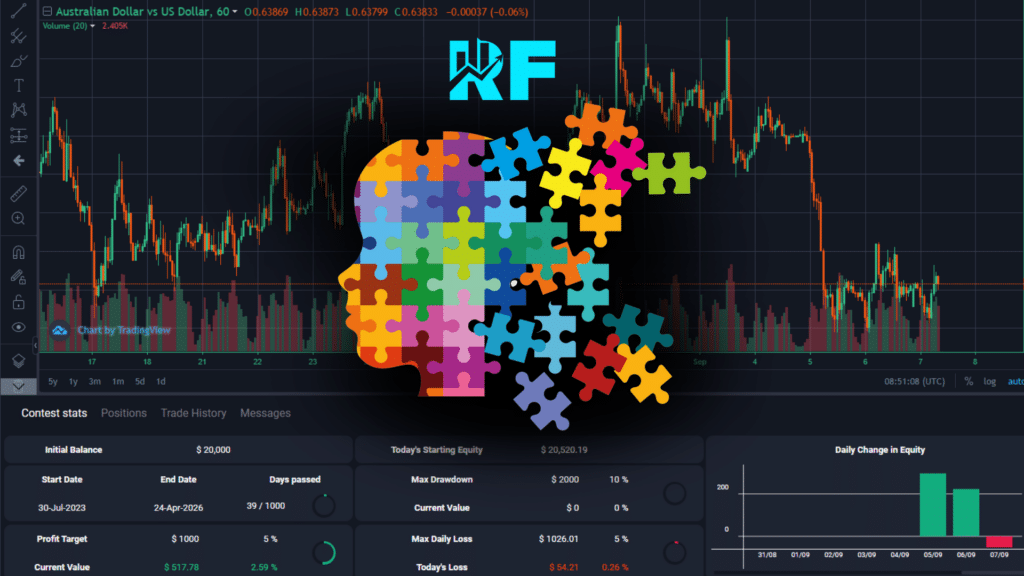14 kognitívnych predsudkov, ktoré môžu zabrániť konzistentným ziskom z obchodovania

Forexové obchodovanie je podnik, ktorý si vyžaduje analytické myslenie. Vyžaduje si schopnosť robiť racionálne rozhodnutia. Ale bohužiaľ, naše mozgy nie sú pri obchodovaní vždy úplne racionálne alebo objektívne. Kognitívne predsudky prispievajú k našej občasnej subjektivite.
Kognitívne predsudky sú mentálne skratky, ktoré môžu ovplyvniť náš rozhodovací proces. Často nás pri obchodných aktivitách vedú na scestie. Ich pochopením a rozpoznaním môžeme zlepšiť svoju obchodnú výkonnosť.
V dnešnom príspevku sa pozrieme na štrnásť kognitívnych predsudkov, ktoré môžu ovplyvniť našu obchodnú výkonnosť, a tiež poskytneme stratégie na zmiernenie ich vplyvu:
1. Nadmerná sebadôvera
K nadmernej sebadôvere dochádza, keď obchodníci preceňujú svoje znalosti alebo majú prehnanú vieru vo svoje schopnosti. To ich zvyčajne vedie k nadmernému riziku. Hoci dôvera je užitočná pri obchodovaní, nadmerná dôvera môže viesť k nadmernému obchodovaniu, impulzívnym obchodným rozhodnutiam a značným stratám. Ak chcete bojovať s nadmernou sebadôverou, pravidelne objektívne vyhodnocujte svoje obchodné stratégie, spochybňujte svoje predpoklady tým, že sa na ne pozeráte z rôznych uhlov pohľadu a možno budete hľadať spätnú väzbu od ostatných.
2. Skreslenie potvrdenia
Potvrdzovacia odchýlka je pri obchodovaní veľmi častá. Je to tendencia vyhľadávať a interpretovať informácie, ktoré potvrdzujú naše existujúce presvedčenie. Obchodníci postihnutí touto predpojatosťou môžu ignorovať varovné signály. Môžu mať tendenciu zameriavať sa len na údaje, ktoré podporujú ich obchodné tézy, alebo na informácie, ktoré sú v súlade s ich existujúcimi presvedčeniami. Ak chcete prekonať túto predpojatosť pri svojich obchodných aktivitách, musíte aktívne vyhľadávať opačné názory. Vykonajte dôkladný prieskum, aby ste pochopili širšiu dynamiku trhu.
3. Averzia voči strate
Averzia voči strate vedie obchodníkov k tomu, že uprednostňujú vyhýbanie sa stratám pred dosahovaním ziskov. Bolesť zo strát pociťujeme intenzívnejšie ako potešenie zo ziskov. Naše rozhodnutia sa začínajú riadiť strachom zo straty. To spôsobuje, že si stratové pozície držíme príliš dlho. Začíname sa zdráhať opustiť stratové obchody a dúfame v obrat. Výsledkom je, že ohrozujeme svoje finančné prostriedky a tiež zmeškávame ziskové príležitosti. Aby sme prekonali averziu voči strate, musíme si stanoviť jasné stop-loss príkazy a dôsledne ich dodržiavať.
4. Zakotvenie skreslenia
K zakotveniu dochádza vtedy, keď sa obchodníci fixujú na konkrétne ceny alebo hodnoty, čo im sťažuje prispôsobenie meniacim sa trhovým podmienkam. Ak napríklad vidíme, že menový pár dosiahol určitú cenovú úroveň, môžeme si zakotviť svoje očakávania a založiť svoje budúce obchodné rozhodnutia na tejto úrovni (aj keď sa dynamika trhu odvtedy zmenila). Ak chcete zmierniť sklon k ukotveniu, neustále prehodnocujte svoje obchodné rozhodnutia a vyhýbajte sa prílišnému pripútaniu k počiatočným cenovým cieľom.
5. Zaujatosť spätného pohľadu
Zaujatosť spätným pohľadom (známa aj ako fenomén „Vedel som to celý čas“) je kognitívna zaujatosť, ktorá nás vedie k presvedčeniu, že sme mohli presne predpovedať výsledok udalosti potom, ako k nej došlo. Vďaka tomu sa cítime ako bohovia. Často nás vedie k preceňovaniu našej schopnosti predpovedať trh a podceňovaniu úlohy neistoty a náhodnosti. Môže to viesť k nadmernej sebadôvere a bezohľadnému obchodovaniu. Zabráňte zaujatosti pri spätnom pohľade tým, že budete podrobne sledovať Váš obchodný denník a objektívne analyzovať svoje rozhodnutia.
6. Heuristika dostupnosti
Heuristika dostupnosti spôsobuje, že obchodníci sa spoliehajú na ľahko dostupné informácie a často ignorujú menej dostupné, ale rovnako dôležité údaje. Bojujte proti tomuto skresleniu používaním komplexného prístupu k prieskumu a analýze trhu.
7. Zaujatosť pripisovania seba samého
Sebapripisovanie vedie obchodníkov k tomu, že si pripisujú zásluhy za úspešné obchody, zatiaľ čo straty pripisujú vonkajším faktorom. Zachovajte si realistické sebahodnotenie a priznajte si úlohu šťastia pri výsledkoch obchodovania.
8. Stádovitá mentalita
Mentalita stáda je tendencia nasledovať dav, aj keď je v rozpore s Vašou vlastnou analýzou. Vyhnite sa tejto predpojatosti tým, že si vytvoríte dobre definovanú obchodnú stratégiu a budete sa jej držať nehľadiac na všeobecné nálady.
9. Skreslenie aktuálnosti
K skresleniu v súvislosti s nedávnymi udalosťami dochádza vtedy, keď majú nedávne udalosti na rozhodovanie väčší vplyv. Prehnane reagujeme na nedávne pohyby na trhu. Ak sa napríklad menový pár posledných niekoľko dní neustále pohybuje jedným smerom, obchodníci môžu predpokladať, že tento trend bude pokračovať donekonečna, čo ich vedie k uzatváraniu obchodov výlučne na základe tohto nedávneho pohybu. Ak chcete prekonať túto predpojatosť, uistite sa, že Vaše obchodné stratégie sú založené na širokom spektre historických údajov, nielen na nedávnych trendoch.
10. Klamstvo hazardného hráča
Omyl hazardného hráča spočíva v presvedčení, že minulé výsledky ovplyvňujú pravdepodobnosti v budúcnosti (aj keď sú jednotlivé udalosti nezávislé a nesúvisia spolu). Forexoví obchodníci postihnutí hazardnou chybou sa môžu domnievať, že ak sa menový pár neustále pohyboval určitým smerom, je pravdepodobnejšie, že sa v nasledujúcom obchode obráti opačným smerom. Ak chcete tento omyl prekonať, vypracujte si obchodný plán založený na dôkladnej analýze, a nespoliehajte sa na myšlienku, že stratová séria sa určite zmení.
11. Efekt dotácie
Efekt dotácie spôsobuje, že obchodníci nadhodnocujú aktíva, ktoré vlastnia. Vedie nás k držaniu stratových pozícií. Bojujte proti tejto predpojatosti stanovením vopred definovaných bodov ukončenia a držte sa ich.
12. Averzia voči ľútosti
Averzia voči ľútosti môže spôsobiť, že obchodníci váhajú s vykonaním potrebných zmien (kvôli strachu z ľútosti). Ak chcete prekonať túto predpojatosť, buďte ochotní akceptovať chyby. Podľa potreby tiež prispôsobujte svoje obchodné stratégie.
13. Kognitívna disonancia
Kognitívna disonancia nastáva vtedy, keď obchodníci ospravedlňujú zlé rozhodnutia, aby znížili psychologický diskomfort. Zostaňte objektívni a vyhnite sa ospravedlňovaniu zlých obchodných rozhodnutí.
14. Ukotvenie k minulým cenám
Zakotvenie v minulých cenách sťažuje úpravu vstupných a výstupných bodov obchodu. Zamerajte sa na aktuálne trhové podmienky a vyhnite sa prílišnému ovplyvňovaniu minulými cenami.
Kognitívne predsudky sú súčasťou ľudskej prirodzenosti, ale pri obchodovaní môžu viesť k nákladným chybám. Preto je dôležité tieto predsudky rozpoznať a aktívne pracovať na potlačení ich vplyvu. To je pre úspešné obchodovanie kľúčové. Vypracujte si disciplinovaný prístup, veďte si podrobné záznamy, vyhľadávajte rôzne pohľady a neustále zdokonaľujte svoje stratégie. Vďaka týmto činnostiam sa môžete pohybovať na finančných trhoch s väčšou objektivitou a zlepšiť svoju celkovú obchodnú výkonnosť.



